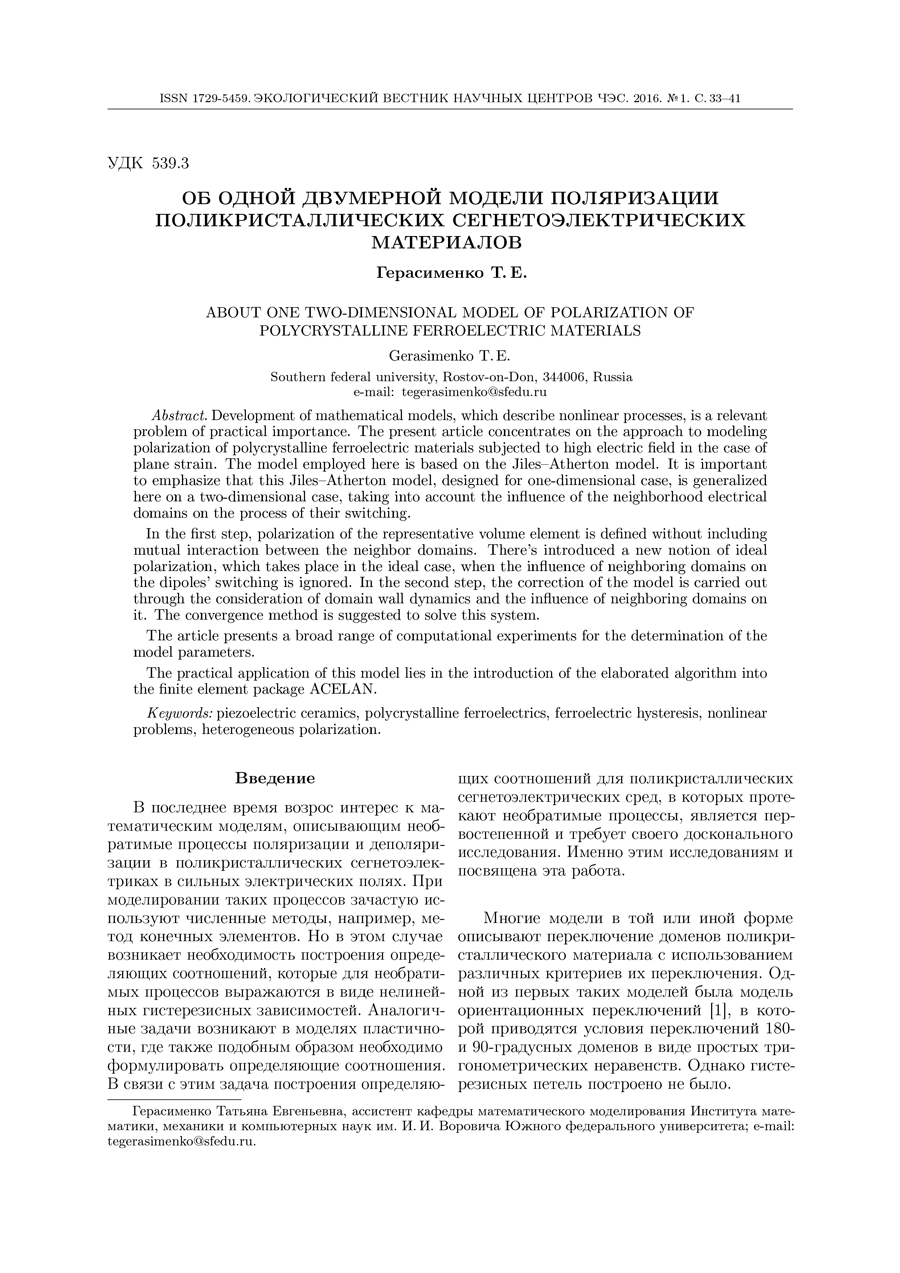About one two-dimensional model of polarization of polycrystalline ferroelectric materials
UDC
539.3Abstract
Development of mathematical models, which describe nonlinear processes, is a relevant problem of practical importance. The present article concentrates on the approach to modeling polarization of polycrystalline ferroelectric materials subjected to high electric field in the case of plane strain. The model employed here is based on the Jiles-Atherton model. It is important to emphasize that this Jiles-Atherton model, designed for one-dimensional case, is generalized here on a two-dimensional case, taking into account the influence of the neighborhood electrical domains on the process of their switching. In the first step, polarization of the representative volume element is defined without including mutual interaction between the neighbor domains. There’s introduced a new notion of ideal polarization, which takes place in the ideal case, when the influence of neighboring domains on the dipoles’ switching is ignored. In the second step, the correction of the model is carried out through the consideration of domain wall dynamics and the influence of neighboring domains on it. The convergence method is suggested to solve this system. The article presents a broad range of computational experiments for the determination of the model parameters. The practical application of this model lies in the introduction of the elaborated algorithm into the finite element package ACELAN.
Keywords:
piezoelectric ceramics, polycrystalline ferroelectrics, ferroelectric hysteresis, nonlinear problems, heterogeneous polarizationReferences
- Fesenko E.G., Danciger A.Ya., Kramarov O.P. Polarizaciya keramiki [Polarization of the ceramics]. Rostov-on-Don, RGU Publ., 1968, 136 p. (In Russian)
- Preisach F. Uber die magnetische Nachwirkung. Zs. f. Phys., 1935, no. 94, pp. 277-302.
- Robert G., Damjanovic D., Setter N. Preisach distribution function approach to piezoelectric nonlinearity and hysteresis. J. of Appl. Phys., 2001, vol. 90, no. 5, pp. 2459-2464.
- Smith R.C., Hom C.L. A domain wall theory for ferroelectric hysteresis. Center for Research in Scientific Computation (CRSC) technical report CRSC-TR99-01. Journal of Intelligent Material Systems and Structures, 1999, vol. 10, no. 3, pp. 195-213.
- Smith R.C., Ounaies Z. A domain wall model for hysteresis in piezoelectric materials. Journal of Intelligent Material Systems and Structures, 2000, vol. 11, no. 1, pp. 62-79.
- Belokon A.V., Skaliukh A.S. Matematicheskoe modelirovanie neobratimykh processov poliarizatsii [Mathematical modeling of irreversible processes of polarization]. Moscow, Fizmatlit Publ., 2010, 328 p. (In Russian)
- Lynch C.S. The effect of uniaxial stress on the electro-mechanical response of 8/65/35 PLZT. Acta mater., 1996, vol. 44, no. 10, pp. 4137-4148.
- Selten M., Schneider G.A., Knoblauch V., McMeeking R.M. On the evolution of the linear material properties of PZT during loading history—an experimental study Int. Journal of Solids and Structures, 2005, no. 42, pp. 3953-3966.
- Akbaeva G.M., Borodin V.Z. Osobennosti processov pereklucheniya segnetomyagkoi keramiki na osnove cirkonata-titanata svinca [Specifics of polarization switching in soft CTS-based ferroelectric ceramic]. Fizika tverdogo tela [Physics of the Solid State]. 2015, vol. 57, iss. 3, pp. 501-505. (In Russian)
Downloads
Issue
Pages
Submitted
Published
How to Cite
Copyright (c) 2016 Gerasimenko T.E.

This work is licensed under a Creative Commons Attribution 4.0 International License.




